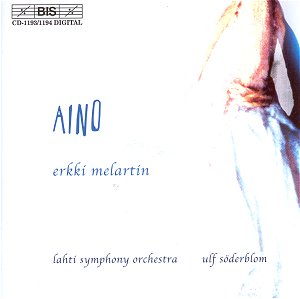Melartin writes in a straightforward late-romantic
idiom somewhat influenced by Sibelius. In Robert Fuchs he shared a teacher
with Sibelius. The Sibelian influence is not so much in the orchestration
(although the woodwind writing in scene iv, Act I is very familiar)
but in the lie of the melody. The idyllic first scene and prelude suggest
the contemporary Omar Khayyam by Granville Bantock, himself a
staunch Sibelian (dedicatee of the Third Symphony).
Aino has a plot drawn from the Kalevala. The
libretto is by Jalmari Finne. The story is largely of the senses and
emotions rather than of dramatic incident. The sleeve-note writer, Veijo
Murtomäki, interprets the opera in terms of Wagnerian leitmotifs
and these are fully printed in the booklet. The outline is that Väinö,
a godly figure, the son of Luonnotar, wants to taste the pleasures of
mortals, and does so with Aino who personifies nature. Väinö
meets Aino and they agree to marry. Aino's brother Jouko opposes the
match and challenges Väinö to a singing match which he loses.
The second act traces the preparations for the wedding and the ceremony
itself. Väinö fashions a kantele, a musical instrument, from
a birch tree. Aino disappears and in the final ecstatic monologue dives
into the sea against the aural tapestry of a chorus of water nymphs.
Remember that this is a philosophical work and despite some very strong
dramatic singing in the first act the work is a stirring meditation
- a vision and a dream - rather than a tale. The opera was premiered
on 5 December 1909. There were revivals in 1912, 1923, 1935, 1941, 1985
and 2000.
This is an ecstatic opera; significantly Melartin called
it a 'Kalevala Mystery'. It stands at the delta from which flows Debussy's
Pelléas et Mélisande and Part I of Bantock's Omar
(especially the glorious Jug of Wine segment). This is not late-romantic
expressionistic writing. There are no hints of Schreker or Zemlinsky.
Rather the writing is luminous, singable, not even as complex as Sibelius's
Luonnotar nor as densely Tchaikovskian as the First Symphony.
Mahler's Fourth Symphony and even Schoenberg's Gurrelieder are
hinted at in the birdsong wind figures in scene ii, Act II. The orchestral
writing reflects the confluence of Sibelius's Second Symphony and Pohjola's
Daughter; there is some notable writing for the harp. As an opera
it relates, in its strenuous romanticism, to Korngold. Melartin, however,
lacks the grittily indelible melodic gift of Korngold or for that matter
of his own countryman Levi Madetoja.
In scenes v and vii of Act I the male chorus sings
at distanced whisper level in the manner of Puccini's chorus in Tosca.
There is also a touch of the choral writing from Kullervo. Melartin
had at least one great advantage in writing for voices and that was
the Finnish language. It must be one of the most singable of tongues.
Its multiple consecutive vowels and precise syllabic emphasis add grittily
relishable distinction to the listening experience. The men's hymn to
nature in scene vii is in the Finno-Ugric tradition of male voice choirs
which is just as vital as the brass band movement in the North of England. The
argent-radiation of the women's voices in scene 5 (Act II) can be linked
with Brahms's guileless Deutsches Volkslieder.
You will look for action in vain for most of the time.
The exception is scene 7 of act II. The interlude from Act II is far
more suggestive of apocalyptic events than that other eschatological
work - Karl Weigl's Fifth Symphony (1945). In fact so well is it conjured
that I began to wonder at moments how Franz Schmidt could possibly have
known this work; so superficially similar is it to the Pale Rider
segments in The Book With Seven Seals. Another apposite
reference is Hans Pfitzner's Deutsche Seele. The dramatic landscape
is more usually undulating and its peaks and troughs are not far distant
from each other. Instead we have a cantata of the reflective as epitomised
by Aino's three invocations including the icy glistening of the moonrise
epilogue.
The recording gives a good impression of depth with
the voices forward but not unduly so. By the way, all the singers acquit
themselves very well with no weak links. There is the odd cough here
and there - but this serves to remind you of what you can so easily
forget - that this recording was made at a series of public concerts.
Each of the two acts is allotted to a single disc (44.58+60.03).
The two discs are housed in a space-saving single-width jewel case.
This presumably explains why the libretto is only in Finnish. To provide
an English translation might have meant that a double-width box would
have had to be used. A pity though as non-Finnish speakers (like yours
truly) are left at the mercy of the booklet's outline narrative.
Students of the Finnish late-romantic scene (most of
whom will already have the six Melartin symphonies, 1903-1924, on Ondine)
will need no second bidding. Others who respond to the comparator works
I have mentioned should also try this piece provided you do not expect
Tosca-like high jinks. It's just not that sort of opera.
Rob Barnett
